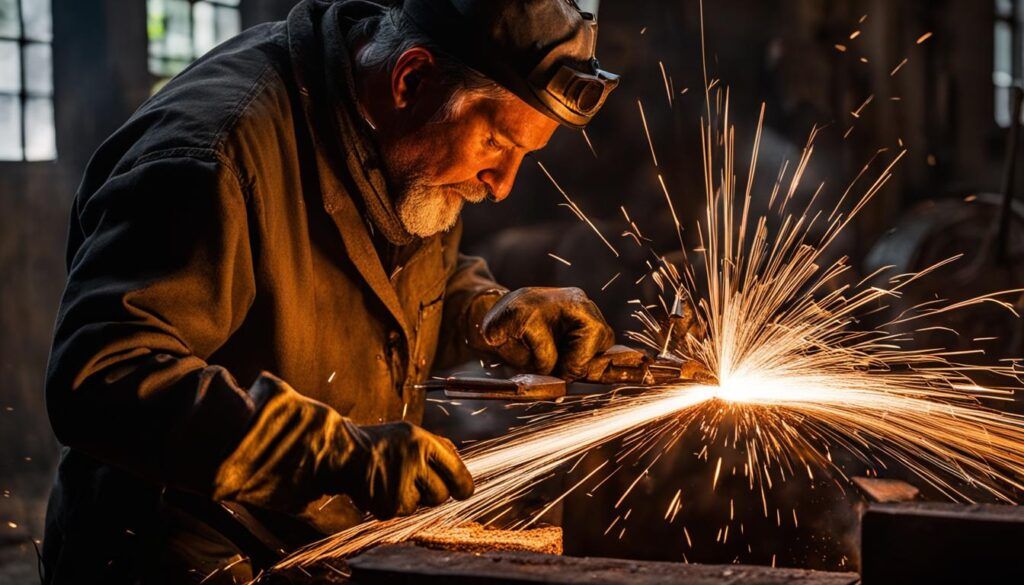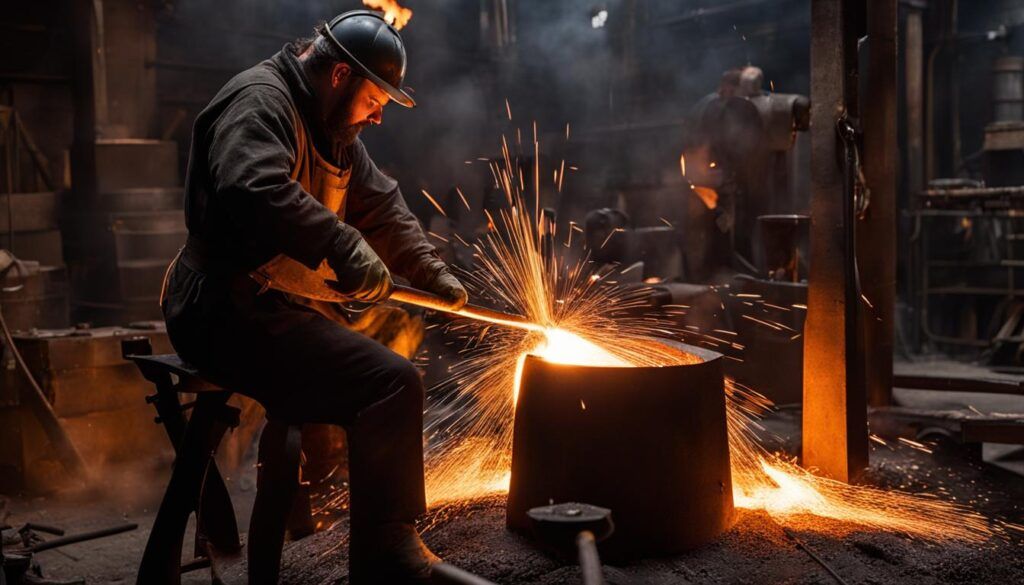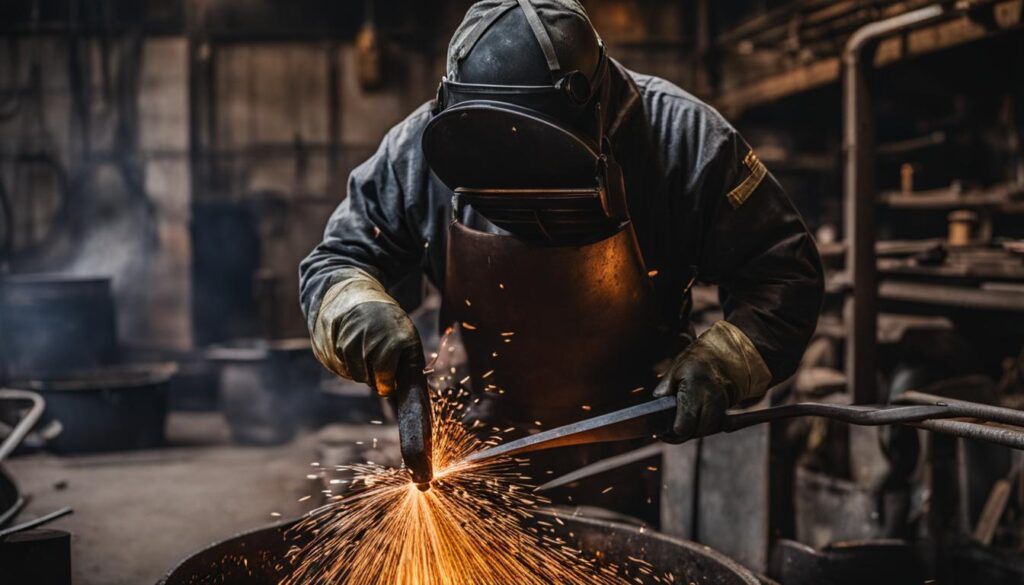The Role Of Alloy Metals In Modern Blacksmithing
- July 15, 2023
Welcome to the fascinating world of blacksmithing! As a blacksmith, you understand the beauty and craftsmanship that goes into creating intricate metalwork. Alloy metals play a crucial role in modern blacksmithing, offering strength, durability, and corrosion resistance that are indispensable in this ancient craft. By combining ancient techniques with the versatility of alloy metals, blacksmiths like you can forge resilient tools, equipment, and artistic pieces that will stand the test of time.
When it comes to blacksmithing, the choice of materials is of utmost importance. While traditional metals have their place, alloy metals provide enhanced properties that make them invaluable in your work. Stainless steel, brass, and titanium are just a few examples of alloy metals that have found their way into the blacksmith’s arsenal.
To ensure your safety and minimize the environmental impact of working with these metals, it’s important to handle and dispose of them properly. Wearing the right protective gear, utilizing designated containers for storage, and adhering to local regulations for disposal are essential practices for responsible blacksmithing.
In this article, we’ll explore the advantages of using alloy metals in modern blacksmithing, delve into the history and evolution of blacksmithing materials, and provide insights into safety measures and environmental considerations. So, let’s dive into the world of blacksmithing with alloy metals!
Key Takeaways
- Alloy metals offer exceptional strength, durability, and corrosion resistance in modern blacksmithing.
- Stainless steel, brass, and titanium are popular choices among blacksmiths for their unique properties.
- Proper handling and disposal of alloy metals are vital for safety and minimizing environmental impact.
- The history of blacksmithing materials spans from ancient copper and bronze to modern alloys.
- By combining ancient techniques with the versatility of alloy metals, blacksmiths can create resilient and enduring metal objects.

Understanding Blacksmithing Materials: Metals and Alloys
In the world of blacksmithing, metals and alloys play a crucial role in shaping the craft. Metals, which are pure elements found in nature, provide the foundation for countless creations. Alloys, on the other hand, are mixtures of two or more metals, offering unique properties that enhance the versatility and strength of blacksmithing materials.
Blacksmiths harness the power of both metals and alloys to forge a wide range of tools, equipment, and artistic pieces. Each material brings its own distinct qualities to the blacksmith’s workshop, allowing for endless possibilities in craftsmanship.
There are several common blacksmithing metals and alloys that are frequently used in the craft. Wrought iron, known for its malleability and low carbon content, was a popular choice in ancient times and is still relied upon today for its distinctive grain and texture.
Steel, a versatile alloy of iron and carbon, is prized for its exceptional strength and resistance to heat. It has become a staple in modern blacksmithing, being used to create durable and reliable tools that can withstand demanding tasks.
Brass, a copper-zinc alloy, is favored not only for its corrosion resistance but also for its stunning aesthetic appeal. Its warm golden hue adds a touch of elegance to blacksmithing creations, making it a popular choice for decorative pieces.
Copper alloys, such as bronze, are another commonly used material in blacksmithing. Bronze, made from a mixture of copper and tin, offers a unique balance of strength and workability, making it ideal for both functional and decorative applications.
Now, let’s take a closer look at these blacksmithing materials and their key properties:
| Material | Key Properties |
|---|---|
| Wrought Iron | Low carbon content, malleable, distinctive grain |
| Steel | Exceptional strength, heat resistance |
| Brass | Corrosion resistance, aesthetic appeal |
| Bronze | Balance of strength and workability |
Each of these materials presents unique opportunities for blacksmiths to forge masterpieces that not only showcase their skills but also stand the test of time.
Continue reading to discover the advantages of using alloys in blacksmithing and how they contribute to the excellence of the craft.
Advantages of Using Alloys in Blacksmithing
When it comes to blacksmithing, alloys offer undeniable advantages over pure metals. The combination of different metals results in enhanced strength, durability, and versatility, making alloys the go-to choice for creating long-lasting tools and products. Let’s explore some key benefits of utilizing alloys in the art of blacksmithing.
1. Increased Strength and Durability
One of the primary advantages of using alloys in blacksmithing is their superior strength and durability. Compared to pure metals, alloys can withstand heavy usage and harsh environmental conditions. Whether you’re forging a robust hammer, a sturdy blade, or any other tool that requires exceptional strength, alloys such as stainless steel, titanium, and brass are the preferred choices.
2. Exceptional Corrosion Resistance
Another significant benefit of alloy metals in blacksmithing is their exceptional corrosion resistance. Many alloy compositions, particularly stainless steel, have inherent resistance to corrosion, making them ideal for outdoor applications or objects that come into contact with moisture or corrosive substances. With alloy metals, you can ensure the longevity and reliability of your blacksmithing creations, even in diverse and challenging conditions.
3. Versatility in Creation
Alloy metals offer blacksmiths a wide range of possibilities in their creative process. By combining different metals, you can customize the properties and applications of the final product. For example, brass alloys not only provide strength and durability but also offer aesthetic appeal due to their warm, golden hue. This versatility in alloy selection allows blacksmiths to create objects with varying properties, colors, and finishes.

4. Accessibility and Availability
Alloy metals are readily available in the market, making them easily accessible to blacksmiths. Stainless steel, titanium, and brass alloys, among others, can be easily sourced from suppliers specializing in metalworking materials. This accessibility ensures that blacksmiths have a consistent supply of high-quality alloy metals to fuel their creativity and craftsmanship.
5. Constructive Collaboration
Using alloys in blacksmithing opens up opportunities for constructive collaboration with other craftsmen and artisans. The unique properties of alloy metals make them compatible with various fabrication processes and techniques, allowing blacksmiths to work in tandem with other professionals from different fields. From jewelry making to architectural design, the versatility of alloys enables collaborative projects that push the boundaries of creativity and craftsmanship.
Note: When working with alloys, it is important to consider the specific composition and characteristics of each alloy. Different alloy metals have distinct properties, melting points, and forging requirements. Blacksmiths should familiarize themselves with the specific techniques and handling procedures required for each alloy they work with to achieve the desired results.
The Advantages of Alloys at a Glance
| Advantages | Description |
|---|---|
| Increased Strength and Durability | Alloys offer enhanced strength and durability compared to pure metals, ensuring long-lasting tools and products. |
| Exceptional Corrosion Resistance | Alloy metals, such as stainless steel, provide excellent corrosion resistance, prolonging the lifespan of blacksmithing creations. |
| Versatility in Creation | With alloy metals, blacksmiths have the flexibility to customize properties, colors, and finishes of their creations. |
| Accessibility and Availability | Alloy metals, such as brass and titanium, are easily accessible from specialized suppliers, ensuring a consistent supply for blacksmiths. |
| Constructive Collaboration | Collaborative projects with other craftsmen and artisans become possible due to the compatibility of alloy metals with various fabrication processes. |
With the advantages of alloys in mind, blacksmiths can leverage their unique properties to create exceptional, long-lasting, and visually appealing products that stand the test of time.
Popular Alloys Used in Modern Blacksmithing
In modern blacksmithing, various popular alloys are utilized to create durable and resilient metal objects. Some of the commonly used alloy metals include stainless steel, brass and copper alloys, and titanium.
Stainless steel is renowned for its exceptional corrosion resistance and outstanding durability. This makes it highly suitable for a wide range of applications in blacksmithing. Whether it’s crafting tools, equipment, or artistic pieces, stainless steel provides the necessary strength and longevity needed to withstand demanding conditions.
Brass and copper alloys are favored not only for their corrosion resistance but also for their aesthetic appeal. These alloys offer a unique combination of durability and visual appeal, making them ideal for creating ornamental pieces that showcase both strength and beauty.
Titanium, with its exceptional strength and remarkable resistance to corrosion, is widely used in various industries, including blacksmithing. It provides blacksmiths with the versatility needed to forge durable and resilient objects that can withstand the test of time.
Overall, these popular alloys offer blacksmiths a wide range of properties and capabilities, allowing them to create high-quality metal objects that meet the demands of modern applications.
| Alloy | Properties | Applications |
|---|---|---|
| Stainless Steel | Exceptional corrosion resistance and durability | Tools, equipment, decorative pieces |
| Brass and Copper Alloys | Corrosion resistance, aesthetic appeal | Ornamental pieces, decorative elements |
| Titanium | Strength, resistance to corrosion | Aerospace components, high-performance tools |
Safety Measures and Environmental Considerations
When working with alloy metals in blacksmithing, it is crucial to prioritize safety and consider the environmental impact of your craft. By following proper safety measures and adopting responsible practices, you can ensure a safe working environment and minimize harm to the environment.
Protective Gear and Equipment
First and foremost, always wear the appropriate protective gear when working with alloy metals. This includes safety goggles, gloves, and protective clothing to shield yourself from potential hazards such as flying sparks or molten metal splatters. Additionally, ensure that your workspace is equipped with fire-resistant materials and a fire extinguisher in case of emergencies.
Proper Handling and Storage
Handle alloy metals with care to avoid accidents or injuries. Ensure that you have a designated area for storing these materials, away from flammable substances and in tightly sealed containers to prevent oxidation. Proper labeling and organization can help you easily identify different types of alloys, reducing the risk of mix-ups and potential hazards.
Disposal and Recycling
Dispose of metal scrap and waste responsibly, following local regulations and guidelines. Recycling alloy metals not only reduces waste but also helps conserve natural resources. Many scrap metal recycling centers accept alloy metals, allowing you to contribute to a sustainable recycling process.
Ventilation and Air Quality
Blacksmithing processes can produce fumes and airborne particles that can be harmful if inhaled. Install a proper ventilation system in your workspace to minimize exposure to these pollutants. This will help maintain clean air quality and protect both your health and the environment.
Adhering to these safety measures and considering the environmental implications of your work will enable you to practice blacksmithing responsibly. By protecting yourself, properly handling alloy metals, and minimizing the environmental impact, you can enjoy the art of blacksmithing while keeping yourself and the planet safe.

A Look into History: Blacksmithing Materials Through the Ages
Throughout history, blacksmiths have utilized various materials to forge their creations. The evolution of blacksmithing materials showcases the advancements and ingenuity of this ancient craft. Understanding the roots and progression of materials used in blacksmithing allows us to appreciate the skill and innovation that shaped the industry.
One of the earliest materials used by blacksmiths was wrought iron. Ancient blacksmiths commonly employed this malleable and sturdy material due to its abundance and ease of manipulation. Wrought iron was valued for its strength and versatility, making it ideal for crafting a wide range of tools, weapons, and decorative items.
Steel quickly gained recognition for its exceptional properties that surpassed those of wrought iron. The introduction of steel brought about notable advancements in blacksmithing. With its superior strength, durability, and resistance to heat, steel revolutionized the production of tools, weapons, and machinery.
Before the widespread use of iron and steel, blacksmiths relied heavily on copper and bronze. These materials, often used in ancient times, offered excellent workability and corrosion resistance. Copper and bronze creations were admired for their aesthetic appeal, and they played a significant role in the development of early civilizations.
As the use of metals became more prominent in blacksmithing, materials like wood and stone gradually took a backseat. The unique properties of metals, such as their superior strength and durability, outshined other materials, leading to their widespread adoption by blacksmiths.

“Blacksmithing materials have evolved alongside human civilization, with each period reflecting the technological advancements and cultural influences of its time.”
The Evolution of Blacksmithing Materials
The following table provides an overview of the evolution of blacksmithing materials:
| Era | Materials | Characteristics |
|---|---|---|
| Antiquity | Wrought Iron, Bronze, Copper | Malleable, abundant, corrosion-resistant |
| Medieval Period | Steel | High tensile strength, heat resistance |
| Modern Era | Various alloys and metals | Enhanced properties, specialized applications |
As blacksmithing techniques advanced and the demand for more specialized products grew, modern blacksmiths began utilizing a wide array of alloys and metals. This included materials such as stainless steel, tool steel, and various other alloy compositions. These alloys possess specific properties tailored to various applications in blacksmithing, driving the craft to new heights of precision and innovation.
By examining the historical use and progression of materials in blacksmithing, we gain a deeper appreciation for the craftsmanship and the significant impact that each era had on the advancements of the industry.
Metal Manipulation and the Use of Alloys in Ancient Times
Metal manipulation techniques such as smelting and forging have been integral to human civilization for thousands of years. These ancient methods laid the foundation for the development of advanced metalwork techniques that shaped the course of history. The discovery of bronze, an alloy of copper and other metals, during the Bronze Age revolutionized ancient metalwork.
Smelting was the process of extracting valuable metals from ores using heat and reducing agents. This technique allowed ancient blacksmiths to obtain a wide range of metals from their natural sources. By heating the ores in a furnace and combining them with reducing agents, such as charcoal or carbon, impurities were removed, resulting in pure metal. The smelting process enabled the production of metals that were otherwise inaccessible or difficult to work with.
“Ancient blacksmiths mastered the art of smelting, harnessing the transformative power of heat to unlock the potential of metals.”
In addition to smelting, ancient blacksmiths also recognized the benefits of employing alloys in their work. Alloys are combinations of two or more metals, carefully chosen and blended to enhance specific properties. By mixing metals, ancient blacksmiths could create alloys with improved strength, durability, and other desirable characteristics.
Harnessing the power of ancient metal manipulation techniques and using alloys, blacksmiths in ancient times were able to create a wide array of objects that served various purposes. Weapons, tools, and decorative items were among the products crafted by skilled ancient blacksmiths.
Ancient Metalwork Examples:
To showcase the diversity and mastery of ancient metalwork, here are a few examples of notable ancient artifacts created through metal manipulation:
- An intricately designed bronze armor from ancient Greece, showcasing the skill of ancient Greek blacksmiths in crafting both protective and artistically stunning pieces.
- A finely forged iron sword from ancient China, a testament to the strength and craftsmanship of ancient Chinese blacksmiths.
- A bronze statue of a deity from ancient Egypt, highlighting the intricate casting processes and artistic abilities of ancient Egyptian metalworkers.
These artifacts serve as a reminder of the remarkable skill and innovation of ancient blacksmiths, who laid the groundwork for the modern blacksmithing techniques and methods we utilize today.
Conclusion
The use of alloy metals has revolutionized modern blacksmithing, providing exceptional strength, durability, and corrosion resistance. Through the integration of ancient techniques and the use of alloys, blacksmiths are able to create resilient tools, equipment, and artistic pieces that can withstand the test of time. Stainless steel, brass and copper alloys, and titanium are popular choices in blacksmithing due to their unique properties and versatility.
However, it is crucial for blacksmiths to prioritize safety and environmental considerations when working with alloy metals. Proper handling, disposal of metals, and the use of protective equipment are essential in ensuring the safety of both the blacksmith and the environment. By adhering to these practices, blacksmiths can minimize accidents and reduce the environmental impact of their work.
Understanding the history and evolution of blacksmithing materials adds depth to the craft. From the use of wrought iron in ancient times to the introduction of steel and alloys, the progression of materials highlights the advancements made in the artistry and science of blacksmithing. Alloy metals have played a significant role in shaping the craft, providing blacksmiths with the tools and materials necessary to create durable and resilient metal objects.
In conclusion, the incorporation of alloy metals in blacksmithing has transformed the industry, offering enhanced strength, durability, and corrosion resistance. Stainless steel, brass and copper alloys, and titanium have become widely used materials, allowing blacksmiths to create a wide range of functional and artistic pieces. By prioritizing safety, considering environmental implications, and understanding the history of blacksmithing materials, blacksmiths can continue to produce exceptional work and contribute to the rich legacy of this ancient craft.
FAQ
What role do alloy metals play in modern blacksmithing?
Alloy metals like stainless steel, brass, and titanium are crucial in modern blacksmithing due to their exceptional strength, durability, and corrosion resistance. Blacksmiths use a combination of ancient techniques and alloy metals to create resilient tools, equipment, and artistic pieces capable of enduring wear and tear over time.
What are the advantages of using alloys in blacksmithing?
Alloy metals offer increased strength, durability, and corrosion resistance compared to pure metals, making them ideal for creating long-lasting blacksmithing tools and products. They provide exceptional versatility, allowing for the creation of a wide range of objects with varying properties and applications.
Which alloys are commonly used in modern blacksmithing?
Popular alloys used in modern blacksmithing include stainless steel, brass and copper alloys, and titanium. Stainless steel is known for its exceptional corrosion resistance and durability, while brass and copper alloys offer corrosion resistance and aesthetic appeal. Titanium is widely used in various industries for its strength and resistance to corrosion.
What safety measures should be taken when working with alloy metals?
Blacksmiths should wear protective gear, store metals in designated containers, use appropriate tools and equipment, and dispose of metal scrap and waste according to local regulations to ensure safety and minimize environmental impact. Proper ventilation systems in the workspace also help control fumes and airborne particles.
What are the historical materials used in blacksmithing?
Throughout history, blacksmiths have used materials such as wrought iron, steel, copper, and bronze. Wrought iron was commonly used by ancient blacksmiths, while steel gained recognition for its strength and heat resistance. Copper and bronze were popular before iron was introduced, and materials like wood and stone became less prominent as metals became more widely used.
How were alloy metals and metal manipulation techniques used in ancient times?
Metal manipulation techniques such as smelting and forging have their roots in ancient civilizations. Bronze, which is an alloy of copper and other metals, played a significant role in ancient metalwork. Smelting involved extracting metals from ore using heat and reducing agents. Alloys were used to enhance the strength and value of metals, and ancient blacksmiths used these techniques to create weapons, tools, and decorative items.
How have alloy metals revolutionized modern blacksmithing?
Alloy metals have revolutionized modern blacksmithing by offering exceptional strength, durability, and corrosion resistance. Their use in creating resilient tools, equipment, and artistic pieces has elevated the craft to new heights. Popular alloys such as stainless steel, brass and copper alloys, and titanium provide blacksmiths with the versatility and properties needed to create durable and resilient metal objects.
Source Links
- https://saskarc.com/en/ancient-blacksmithing-techniques-still-used-fabrication-today/
- https://www.bostonironworks.com/blog/a-look-into-history-blacksmithing-materials-through-the-ages/
- https://craftskills.blog/blacksmithing/types-metal-their-uses/alloy-metals/the-role-of-alloy-metals-in-modern-blacksmithing/
